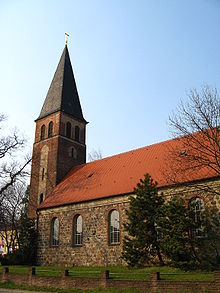Biesdorf village church
The Protestant village church Biesdorf , which bears the name Gnadenkirche , is located in the Berlin district of Biesdorf . It is one of the first churches on Barnim . However, with the exception of the walls surrounding the nave, all other components are more recent. It is unusual that it was conceived as a hall church from the start and that it differed significantly from the design common in the High Middle Ages (west tower, nave, choir , apse ).
history
Like the other village churches in the Barnim area around Berlin, the village of Biesdorf was built around 1230. The dating of the village church runs into a problem. It was built as a hall church because there are no signs of medieval additions (tower, retracted choir or apse). Hall churches were generally only built from 1300 (exception : Schmargendorf village church : towards the end of the 13th century). On the other hand, there is an added arched portal on the western north wall . The round arch is a characteristic of late Romanesque , so only in exceptional cases after 1250. In addition, two added portals can be seen on the south wall, of which the western one probably had a round arch; however, this finding is not unequivocal. So the church (like Schmargendorf) will have to be placed in the last quarter of the 13th century. The second half of the 13th century is also considered to be the time of the so-called transition style .
In 1375, Biesdorf appears for the first time in the land register of Emperor Charles IV , with 62 hooves , four of which are parish hooves and one church hoof. Pastor, church and landlord Henning von der Gröben are noted here. Before 1472, the church patronage passed to the von Pfuel, who were also the landlords of Biesdorf (until 1665).
In the course of time, two branches came to the Biesdorf church , the daughter churches Kaulsdorf (since 1541) and Mahlsdorf (since 1692).
In 1682 the church was renovated and rebuilt, and in 1695 a new pulpit was added. In 1702 a square tower in baroque forms, i.e. plastered, was completely rebuilt. In 1720 seven windows were broken out and the choir renewed.
In 1754 the church burned down completely. The inventory was partially saved, but much was lost during the Russian occupation in the Seven Years' War in 1762 . In 1756 the newly built church was consecrated, and in 1789 a new rectory was added.
There has been an organ in the Biesdorf village church since 1824 , which also became the seat of the superintendent that year .
In 1896/1897 the village church was built according to plans by the architect Ludwig von Tiedemann with the addition of a new rectangular, aisle-wide tower in the "cathedral style" (as in the Kaulsdorf village church ) made of brick with a basement made of Rüdersdorf limestone (with a pointed helmet) and a semicircular apse converted into a neo-Gothic town church; at the same time the windows were enlarged. In 1907 the parish of Biesdorf was divided, Kaulsdorf and Mahlsdorf were now separate parishes .
In 1917 the bronze bells, with the exception of the smallest bell, and the pewter organ pipes for weapons production were delivered. The bell could not be renewed until 1925, but in 1942 it was again important for the war effort and had to be delivered.
On January 20, 1944, the church was destroyed in a bomb attack on Biesdorf.
Reconstruction began in July 1950 and the Gnadenkirche was consecrated again in October 1951. The reconstruction was carried out according to a design by Herbert Erbs using the masonry of the ruin and the preserved tower in simple shapes, so that the building again looks more like a village church. Expressionist elements are the dark barrel vault , the altar and the pulpit, which were made of red clinker . The font dates from 1958. In 1978 the windows were renewed.
The road layout was changed around 1985. Since then, the former village green with the Gnadenkirche has been on an island in the traffic flow of the B1 / B5 . Almost a century earlier, a large part of the former Biesdorf cemetery had been destroyed as a result of the expansion of the R1 .
literature
- Kurt Pomplun: Berlin's old village churches. 4th edition, Haude & Spenersche Verlagbuchhandlung, Berlin 1973, ISBN 3-7759-0160-4 .
- Old Berlin village churches. Heinrich Wohler's drawings , ed. v. Renate and Ernst Oskar Petras, Berlin 1988.
- Markus Cante: Churches until 1618. In: Berlin and its buildings, Part VI: Sacred buildings. Ed .: Architects and Engineers Association of Berlin , Berlin 1997, p. 335.
- Matthias Friske : The medieval churches on the Barnim. History - architecture - equipment. Lukas-Verlag, Berlin 2001 (Churches in Rural Areas, Vol. 1), ISBN 3-931836-67-3
Web links
Coordinates: 52 ° 30 ′ 32.4 " N , 13 ° 33 ′ 19.8" E





